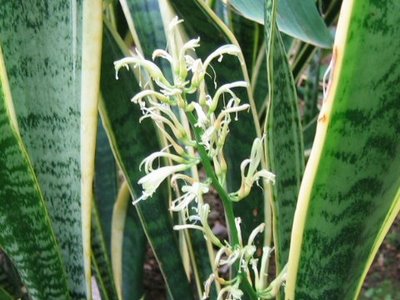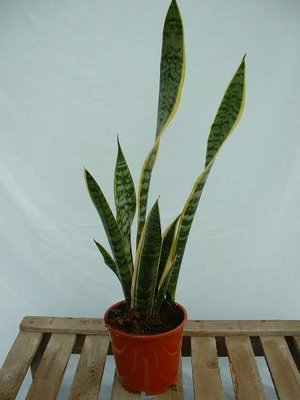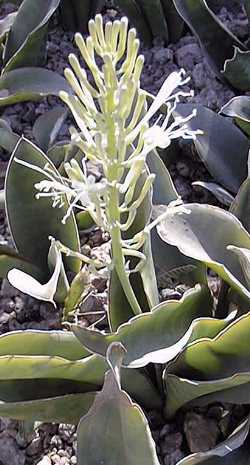Sansevieria

Picture showing the flowers of Sansevieria
Thousands of households and offices have pots of "Mother-in-law's tongue" or "Snake plant" sitting in a dark corner gathering dust. For many of us, this is the only exposure to the wonderful Sansevieria plant family. This plant can even flower!
Sansevierias is a group of about 60 Agave related species from India, Indonesis and tropical Africa. A couple of species are common as house plants.
Sansevierias flowers are white on an unbranched spike, vaguely reminiscent of a hyacinth. They are often scented, particularly in the evening. They are propagated by seeds, suckers or leaf cuttings.
They are very tolerant of poor growing conditions and low light. If you water them once a week or every two weeks, they will be happy. The only mistake you can make with them is over-watering. Growing them in a peat-based potting media is best provided you have added perlite or vermiculite for drainage.
The Sansevieria or "Mother-in-law's Tongue" got its name from its tapering leaves that resemble a tongue. The tough fleshy leaves of the plant contain fibres and have two different colours: the middle part being a darker green while the outer part is a lighter green.
Sansevierias grow from rhizomes. When potting them up, make sure the rhizomes are covered but don't bury the base of the leaves. Use gravel to cover the soil. This helps to keep water from collecting at the base of the plant and provides support while the plant is settling into its new home. They may be top heavy until they are firmly rooted. Since this plant prefers to be pot bound, plan on leaving it in the pot for several years. The tall varieties have deep pots while the dwarf varieties are grown in shallow pots.
Only a few Sansevieria species are commonly found in florist shops or garden centers. These are the Sansevieria trifasciata varieties. Most garden center plants are S. trifasciata or S. trifasciata var. Laurentii which has a yellow strip on the edge of the leaves. With good light and cultivation these plants may grow up to 5 feet tall. In most settings, they average 2-3 feet tall. These are succulent plants with thick, sword-like leaves.
Some shops carry the S. trifasciata 'Hahnii' which is a dwarf variety forming a low rosette of leaves. Unfortunately, it is rare to find any other varieties in local florist shops or garden centers.

Picture of Sansevieria hyacinthoides
One reason this plant species interests me so much is that S. trifasciata often sends up leaves looking very different from the original plant but growing from the same rhizome. These are referred to as "sports". Plant growers isolate these sports and begin developing a new plant variety. If they are able to propagate it, collectors will have a new variety to grow. Specialty nurseries carry many varieties looking very different from your standard "Snake plant".
One of my favorite species is S. trifasciata ‘Bantel's Sensation'. It has green and white stripes running the full length of its leaves. I have found it to be very sensitive to over-watering and find that 2-3 times a month is the most--otherwise it tends to succumb to rot. My favorite dwarf variety is S. trifasciata ‘Golden Hahnii' which is gold and green striped. It too is very sensitive to over-watering.







0 Comments:
Post a Comment
<< Home